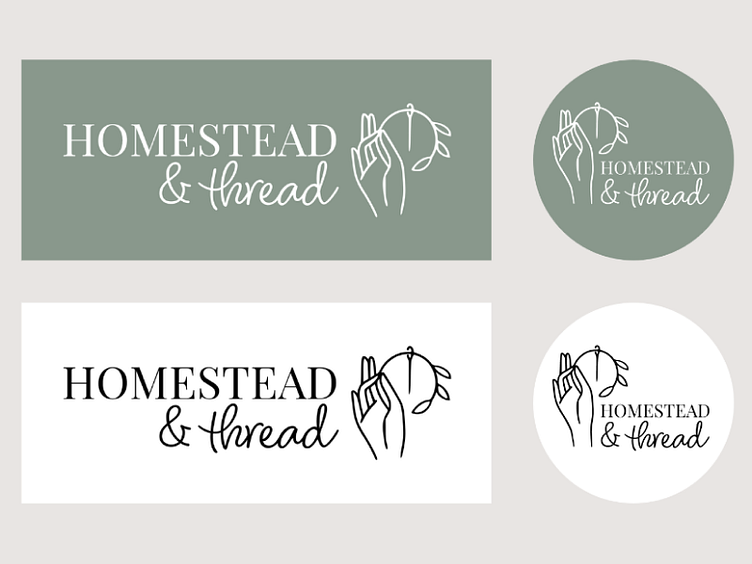Homestead + Thread Embroidery Shop Branding and Web Design
Our story begins in quintessential 2023 style:
Val posted an Instagram Reel for her Etsy shop. It went viral.
Since then, she's had an influx of orders and social media engagement. While celebrating the growth in her business and mission to motivate people to learn embroidery, she quickly realized that she needed more than just an Etsy shop to maximize this opportunity.
Val and I became Instagram friends through mutual interest and admiration for each other's work (my passion project happens to be an Etsy shop as well). When I mentioned in a post that I also do UX design and branding work, Val reached out and asked for help with scaling her business.
We scheduled a 30-minute meeting for the next morning. We talked for almost 2 hours.
Needle-less to say (embroidery puns, anyone? 🧵), we've had a great time working together.
Money on the (craft) table
Val's customers and followers ask lots of questions about supplies, techniques, and embroidery recommendations. While this is every creator's dream, Val noticed that in sharing her threads of wisdom (anyone?), she's basically providing free advertising to several large businesses. It's 2023, and Val knows that she can use her platform to earn commission for her efforts through affiliate marketing programs, without any additional charge to her community. In other words, there's extra income up for grabs.
The Problems:
Homestead and Thread's brand kit is incomplete. As the business scales, this will lead to inconsistent messaging and identity, as well as some accessibility issues with the color palette.
Val cannot apply for affiliate marketing programs because she does not have her own website (i.e. a URL that isn't owned by Etsy).
If Etsy or Instagram disappeared tomorrow, or if the almighty algorithms were to change, Val's customer base, and therefore revenue, would take a serious hit.
The Goals:
Refine Homestead and Thread's existing brand kit and optimize colors and fonts for accessible viewing.
Build an additional sales channel via a Shopify store.
Set up a blog on the Homestead and Thread website for Val to post embroidery tutorials and recommendations (hello, affiliate marketing!)
Create a Homestead and Thread email list to deepen customer relationships while building an algorithm-proof method of communication that's entirely owned by Val.
Branding
Val came to me with a strong idea of what she wanted for her brand. She also gave me a brand kit that she had started for her business 👇
She wanted a clean and simple style with the "warmth and coziness of a farm/homestead". As a fellow lover of this style, I knew I could work with that.
Logos
The biggest change I made to the logo was the typography. I used the header typeface of Playfair Display for the word "Homestead". I used Blithe for "& thread" to add some playful contrast, and converted the font to an outline to stretch and distort some of the letters to fill some negative space in the logo.
I made these changes to preserve the feel of the cursive font in the original brand kit, while ensuring that the text was easy to read.
Val chose the rectangular variation to be the main logo, but I also sent her the circular variation to play around with for packaging or other smaller spaces.
Color palette
The earth tones accompany Val's content and products beautifully, so I wanted to preserve that as much as possible. The most-used shade is that beautiful green, chosen intentionally by Val to be inviting to customers. I kept that shade exactly as is, and slightly tweaked the other colors to have better contrast for accessibility while still giving good visual variety.
I made 2 main changes:
I lightened up the neutral shades so that black text could be placed over them as needed.
I made the gold a little more saturated to use as an accent color. Val wanted to keep the gold as much as possible, and I thought it would make a beautiful Call To Action button color.
Typography
I loved that Val chose Avenir for her body text because it's crisp and easy to read. I changed the body text to Muli simply for ease of use. Muli is built in to both Shopify and Canva, so Val can stay consistent wherever she's working.
For the header, I chose Playfair Display because it provides enough contrast to Muli but it's easier to read than a handwriting-style font. That said, I still kept the handwriting/cursive look for the logo as mentioned above.
The website
Val's Shopify site is still in its early stages, but I'll update this post once the site is live. In the meantime, here's a small preview:
Lessons learned
Teaching skills can truly transfer anywhere. In project-based freelance work, part of the work is setting up your client for future success. The former teacher in me had her moment writing instructions for using brand elements (i.e. font pairings) and updating Shopify. True client trust is built when you show them you're thinking of longevity.
Shopify is one of the more user-friendly site builders out there, which makes sense since it's designed for business owners who aren't necessarily tech-savvy. But if you know how to code, holy smokes. Shopify is your oyster. *adds "learn code" to to-do list*
Crafty people are my people. Especially the entrepreneurial ones.
💬I'd love to hear from you!
What feedback do you have for me? Questions? Words of wisdom? Additional embroidery puns? Let me know!
📍Other places you can find me:





